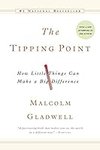
The Tipping Point

A critic looking at these tightly focused, targeted interventions might dismiss them as Band-Aid solutions. But that phrase should not be considered a term of disparagement. The Band-Aid is an inexpensive, convenient, and remarkably versatile solution to an astonishing array of problems.
Malcolm Gladwell • The Tipping Point
Of those who have ever tried cocaine, less than one percent—0.9 percent—are regular users.
Malcolm Gladwell • The Tipping Point
But do you know what the experimentation statistics are for illegal drugs? In the 1996 Household Survey on Drug Abuse, 1.1 percent of those polled said that they had used heroin at least once. But only 18 percent of that 1.1 percent had used it in the past year, and only 9 percent had used it in the past month.
Malcolm Gladwell • The Tipping Point
About 80 percent of alcoholics smoke. Close to 90 percent of schizophrenics smoke.
Malcolm Gladwell • The Tipping Point
Of those who had at some time in their lives been diagnosed with a major psychiatric disorder, 74 percent had smoked at some point, and 14 percent had quit smoking. Of those who had never been diagnosed with a psychiatric problem, 53 percent had smoked at some point in their life and 31 percent had managed to quit smoking.
Malcolm Gladwell • The Tipping Point
“In other words, effects of rearing variation (e.g. parents’ lighting up or not, or having cigarettes in the home or not) were essentially nil by the time the children reached adulthood,” the psychologist David Rowe writes in his 1994 book summarizing research on the question, The Limits of Family Influence.
Malcolm Gladwell • The Tipping Point
The questions of how sticky smoking ends up being to any single person, in other words, depends a great deal on his or her own particular initial reaction to nicotine.
Malcolm Gladwell • The Tipping Point
The average smoking household spends 73 percent more on coffee and two to three times as much on beer as the average nonsmoking household.
Malcolm Gladwell • The Tipping Point
Stories about suicides resulted in an increase in single-car crashes where the victim was the driver. Stories about suicide-murders resulted in an increase in multiple-car crashes in which the victims included both drivers and passengers. Stories about young people committing suicide resulted in more traffic fatalities involving young people.
... See more